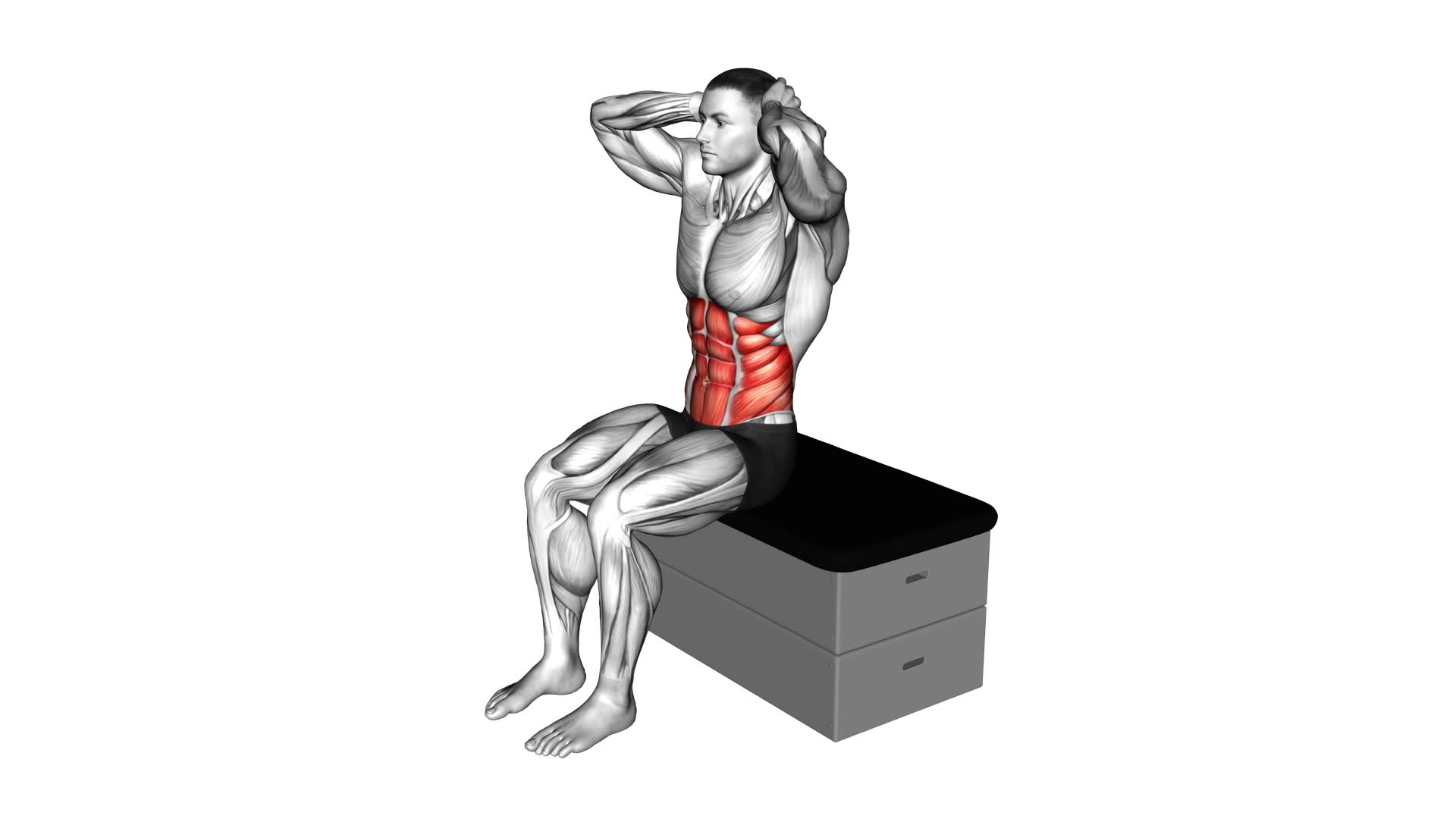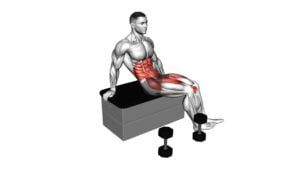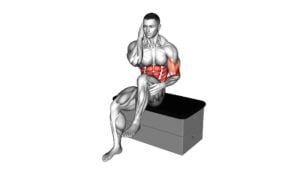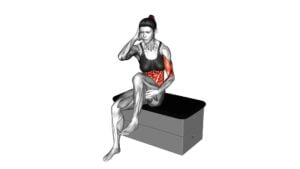Sitting Side Bend on a Padded Stool – Video Exercise Guide & Tips

Are you looking to strengthen your core and improve your flexibility? Look no further than the sitting side bend on a padded stool exercise.
Watch This Exercise Video
In this video guide, we'll show you the proper form and technique to achieve maximum results. Whether you're a beginner or advanced, we have modifications for all levels.
Learn how to avoid common mistakes and get tips for maximizing the effectiveness of this exercise.
Get ready to feel the burn!
Key Takeaways
- The sitting side bend exercise strengthens oblique muscles and enhances core stability.
- It improves flexibility, range of motion, and posture.
- The exercise can alleviate lower back pain.
- Beginners can modify the exercise by reducing range of motion or using lighter weights, while advanced individuals can challenge themselves with higher stools or added weights.
Benefits of the Sitting Side Bend Exercise
Strengthen your oblique muscles with the sitting side bend exercise. This exercise has numerous benefits that can improve your overall fitness and posture. One of the main benefits is that it targets and strengthens your oblique muscles, which are located on the sides of your abdomen. By doing this exercise regularly, you can develop stronger and more defined obliques, which can enhance your core stability and help to prevent injuries.
Additionally, the sitting side bend exercise can improve your flexibility and range of motion. As you lean sideways while seated, you stretch your side muscles, including the obliques, which can increase your overall flexibility. This exercise also engages your lower back muscles, which can help to alleviate lower back pain and improve your posture.
Another benefit of the sitting side bend exercise is its versatility. There are several variations you can try, such as using dumbbells or resistance bands to add resistance, or incorporating twists or rotations to engage different muscles. These variations can make the exercise more challenging and target different muscle groups, providing a well-rounded workout for your core.
Proper Form and Technique
To ensure proper form and technique for the sitting side bend exercise, focus on engaging your core muscles and maintaining a tall, upright posture. Proper form and technique are essential for maximizing the benefits of this exercise. By engaging your core muscles, you stabilize your spine and promote better alignment throughout your body. This not only helps to prevent injury but also enhances the effectiveness of the exercise. Additionally, maintaining a tall, upright posture ensures that you're targeting the correct muscle groups and avoiding unnecessary strain on your back.
The benefits of proper form during the sitting side bend exercise are numerous. First and foremost, it allows you to effectively target and strengthen your oblique muscles, which are vital for maintaining a strong and stable core. It also helps to improve flexibility and range of motion in your spine, promoting better posture and reducing the risk of back pain. Additionally, proper form and technique ensure that you're engaging the correct muscles, avoiding compensation from other muscle groups, and maximizing the overall effectiveness of the exercise.
Now that you understand the importance of proper form and technique, let's move on to the next section, which discusses the equipment needed for the sitting side bend exercise.
Equipment Needed for the Exercise
Now let's talk about what you'll need for the sitting side bend exercise: equipment. When it comes to performing different variations for seated side bend exercises, having the right equipment can make a significant difference in your workout experience.
The main piece of equipment you'll need is a padded stool or bench. This will provide support and comfort while you perform the exercise.
There are different types of seated side bend exercises, and each may require specific equipment. For instance, if you're doing a seated side bend with dumbbells, you'll need a pair of dumbbells that are suitable for your fitness level. The weight of the dumbbells will depend on your strength and ability.
If you're looking to challenge yourself further, you can also use resistance bands during your seated side bend routine. These bands provide additional resistance, helping you engage your core and side muscles even more.
As you progress and become more comfortable with the exercise, you may want to explore other variations and add-ons. However, it's important to start with the basic equipment mentioned above.
Once you have mastered the seated side bend with the appropriate equipment, you can then move on to modifications for beginners and advanced levels.
Modifications for Beginners and Advanced Levels
Now let's talk about modifications for beginners and advanced levels of the sitting side bend on a padded stool exercise.
If you're a beginner, there are options to make the exercise more accessible, such as using a lower stool or reducing the range of motion.
On the other hand, if you're more advanced, you can challenge yourself by using a higher stool or adding weights to increase the intensity.
Effective modification techniques can help tailor the exercise to your fitness level and goals.
Beginner Modification Options
Using a padded stool, you can modify the Sitting Side Bend exercise to accommodate beginners and advanced levels. Here are three beginner modification options to help you get started:
- Reduce the range of motion: Instead of leaning too far to the side, start with a smaller bend and gradually increase as you gain strength and flexibility.
- Use a lighter weight or no weight at all: If you find it challenging to hold a weight while performing the exercise, try using a lighter dumbbell or no weight until you feel comfortable.
- Perform the exercise seated on the floor: If sitting on a stool is too difficult, try sitting on the floor with your legs extended in front of you. This can provide added stability and make the exercise more accessible.
These modifications allow beginners to gradually build strength and confidence while still reaping the benefits of the Sitting Side Bend exercise.
Advanced Level Modifications
To further challenge yourself and take the Sitting Side Bend exercise to an advanced level, consider these modifications for beginners and advanced levels.
For advanced level variations, you can try using a heavier weight or resistance band to intensify the side bend movement. This will engage your oblique muscles even more and enhance the overall effectiveness of the exercise.
Another advanced level progression is to perform the side bend exercise on an unstable surface, such as a Bosu ball or a balance board. This will require more core stability and control, providing a greater challenge for your muscles.
Remember to always maintain proper form and listen to your body's limits when attempting these advanced variations.
Effective Modification Techniques
For an effective modification technique for the Sitting Side Bend exercise, consider using lighter weights or resistance bands to make the movement more accessible and manageable for beginners.
Here are three modification techniques that you can try:
- Reduce the resistance: Start with lighter weights or use resistance bands with less tension. This will help you build strength gradually without straining your muscles.
- Decrease the range of motion: Instead of bending sideways as far as you can, limit your movement to a comfortable range. This will allow you to focus on proper form and prevent any discomfort or injury.
- Perform the exercise seated on a stable surface: If using a padded stool feels challenging, try sitting on a regular chair or a stability ball. This will provide more stability and support for your body.
Common Mistakes to Avoid
To avoid common mistakes while performing the Sitting Side Bend on a Padded Stool exercise, remember to maintain proper form and engage your core muscles throughout.
One of the most common errors isn't using the stool correctly. Make sure to position yourself in the center of the stool with your feet firmly planted on the ground. This will provide stability and prevent any unnecessary wobbling or tipping.
Another mistake to avoid is using excessive momentum during the side bend movement. Remember, the goal of this exercise is to target and strengthen your oblique muscles, so it's important to perform the movement in a controlled manner. Avoid leaning too far to the side or using your arms to push yourself up. Instead, focus on using the strength of your obliques to initiate the movement.
Lastly, be mindful of your posture throughout the exercise. Keep your spine straight and avoid slouching or rounding your shoulders. By maintaining proper form and avoiding these common mistakes, you can maximize the effectiveness of the Sitting Side Bend on a Padded Stool exercise and prevent any potential injuries.
Tips for Maximizing the Effectiveness of the Exercise
To maximize the effectiveness of the exercise, utilize proper breathing techniques. Deep breaths in through the nose and out through the mouth can help you engage your core and stabilize your body during the sitting side bend on a padded stool.
In addition to proper breathing, here are some tips for maximizing results and targeting different muscle groups:
- Vary the stool height: Adjusting the height of the padded stool can change the intensity of the exercise. Lowering the stool will increase the challenge on your obliques, while raising it will engage your lower back muscles more.
- Try different arm positions: Experiment with placing your hands behind your head, on your hips, or extended overhead. Each arm position will target different muscle groups, allowing you to work your entire core effectively.
- Incorporate side stretches: After completing the sitting side bend on the padded stool, incorporate some side stretches to further engage your obliques. Stand up straight, raise one arm overhead, and lean gently to the opposite side. Hold the stretch for 15-30 seconds on each side.
Frequently Asked Questions
How Many Sets and Repetitions Should I Do for the Sitting Side Bend Exercise?
To get the most out of the sitting side bend exercise, it's important to know how many sets and repetitions to do. Sets refer to the number of times you perform a group of repetitions. Repetitions are the number of times you do the exercise in each set.
The ideal number of sets and repetitions can vary depending on your fitness level and goals. It's best to consult with a fitness professional to determine the appropriate number for you.
Can I Do the Sitting Side Bend Exercise if I Have a Back Injury?
If you have a back injury, it's important to proceed with caution when doing the sitting side bend exercise. This exercise involves bending your spine, which can put strain on your back.
It's best to consult with a medical professional or a qualified fitness instructor who can provide modifications or alternative exercises that will be safer for your back.
Remember to prioritize your health and listen to your body's signals.
Is It Necessary to Use a Padded Stool for the Sitting Side Bend Exercise, or Can I Use a Regular Chair?
You don't necessarily need a padded stool for the sitting side bend exercise. A regular chair can work just fine. However, using a padded stool can provide added comfort and support.
The benefits of the sitting side bend exercise include stretching and strengthening your side muscles. If you have a back injury, it's important to modify the exercise to avoid any pain or discomfort.
Always consult with a healthcare professional before starting any exercise program.
Can the Sitting Side Bend Exercise Help Me Achieve a Smaller Waistline?
The sitting side bend exercise can definitely help you achieve a smaller waistline. This exercise specifically targets the oblique muscles, which are responsible for the side-to-side movements of your torso.
By incorporating the sitting side bend exercise into a comprehensive waist slimming workout routine, you can effectively strengthen and tone your obliques, resulting in a more defined waistline.
How Long Should I Hold Each Side Bend Position During the Exercise?
When doing the sitting side bend exercise, it's important to know how long to hold each position and maintain proper form.
Holding each side bend position for around 10-15 seconds is a good starting point. This allows your muscles to engage and stretch properly.
However, as you become more comfortable with the exercise, you can increase the duration to 20-30 seconds.
Remember to maintain proper form by keeping your back straight and your core engaged throughout the exercise.
Conclusion
In conclusion, the sitting side bend exercise is a beneficial movement that targets the oblique muscles and improves flexibility and core strength.
By maintaining proper form and using the necessary equipment, this exercise can be modified for individuals of different fitness levels.
Avoiding common mistakes and following the tips provided will help maximize the effectiveness of the exercise.
Incorporate the sitting side bend into your workout routine to enhance your overall fitness and achieve a stronger and more toned midsection.

Author
Years ago, the spark of my life’s passion ignited in my mind the moment I stepped into the local gym for the first time. The inaugural bead of perspiration, the initial endeavor, the very first surge of endorphins, and a sense of pride that washed over me post-workout marked the beginning of my deep-seated interest in strength sports, fitness, and sports nutrition. This very curiosity blossomed rapidly into a profound fascination, propelling me to earn a Master’s degree in Physical Education from the Academy of Physical Education in Krakow, followed by a Sports Manager diploma from the Jagiellonian University. My journey of growth led me to gain more specialized qualifications, such as being a certified personal trainer with a focus on sports dietetics, a lifeguard, and an instructor for wellness and corrective gymnastics. Theoretical knowledge paired seamlessly with practical experience, reinforcing my belief that the transformation of individuals under my guidance was also a reflection of my personal growth. This belief holds true even today. Each day, I strive to push the boundaries and explore new realms. These realms gently elevate me to greater heights. The unique combination of passion for my field and the continuous quest for growth fuels my drive to break new ground.







